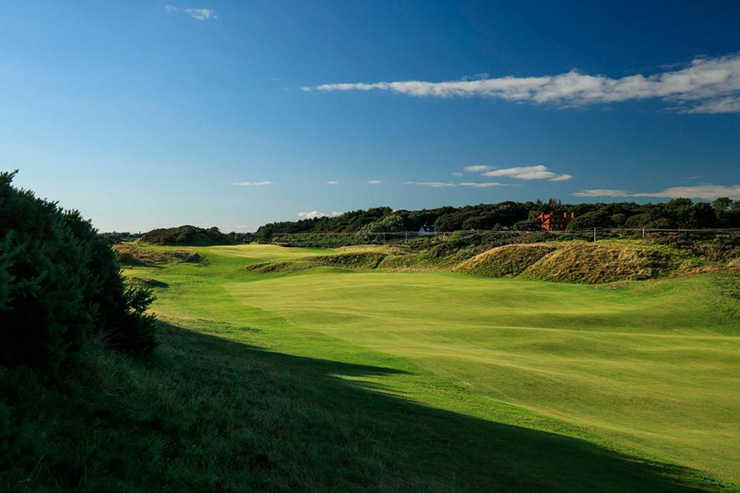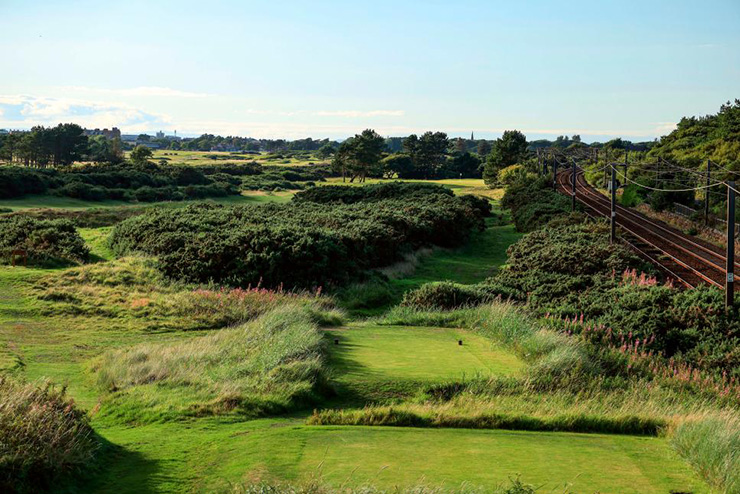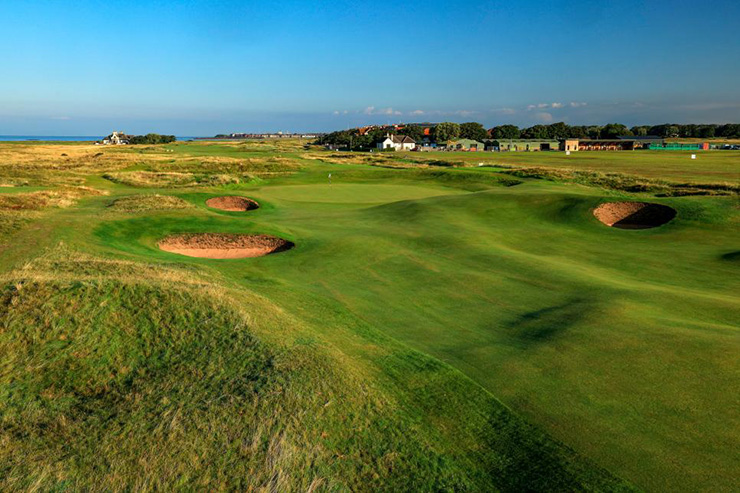Royal Troon Golf Club in Scotland, host of the 152nd Open Championship, is exactly what we envision links golf to be, an out-and-back stroll across a sublime crescent of tousled nature, one dune in from the sea, the rumpled turf dog trotting through buckshot patterns of stern and sod-faced pot bunkers. It’s also not quite what we envision, a droll march over bland and barren regions of flattish fairway, a dead-end turn at a holiday park (what in the United States we call a trailer park) and aeroplanes strafing play from nearby runways.
When the British Open is played at Troon, which has happened nine previous times since 1923, the links can extract the best from titans like Bobby Locke, Arnold Palmer and Tom Watson. Troon is also capable of producing clunkers like Arthur Havers and Todd Hamilton. The nine-out, nine-in routing guarantees Troon will be a tale of two courses: If the wind is at the back one direction, it’s in the face the other; off the firth on the right going out, it’s from the left coming home. Shaped shots and a mastery of trajectory are necessary to play well. These are the five holes that will have the greatest impact on the British Open.
Postage Stamp

David Cannon/R&A
HOLE 8 / 123 YARDS / PAR 3
The first five and a half holes plunge straight ahead over bumpy but level ground along the Firth of Clyde with clear-day views across the water of Ailsa Craig before veering left at the seventh into higher dunes. The game at Troon doesn’t really begin until the round reaches the sandhills, specifically the par-3 eighth Postage Stamp, one of golf’s most famous holes. It plays from an exposed, 20-foot-high dune ridge across a valley to a narrow fingernail of green surrounded by five deep bunkers awaiting shots that will teeter off the crested edges. On a calm day it’s a sand wedge for Open contestants, but those days are rare, and in strong head or crosswinds it’s Troon’s most dangerous shot.
Sandhills

David Cannon/R&A
HOLE 10 / 450 YARDS / PAR 4
At Troon, you need to steal as much as you can going out because you’re going to spend it, and more, coming in. After reaching the southeasternmost point of the property near the holiday park, the 10th turns in the other direction and begins the long odyssey back, typically into the wind. The drive is blind over the eponymous sandhills, and long hitters can try to cheat the hole by cutting off more of the dune on the left, though balls running through the fairway will find a series of hollows, leaving long, blind approaches into a green benched into another tall dune. There are no bunkers on the hole, but the right front of the green falls steeply away and will repel any miscalculated approach.
The Railway

David Cannon/R&A
HOLE 11 / 498 YARDS / PAR 4
The expansion of golf across Scotland in the 19th century follows almost one-to-one the expansion of the country’s rail lines, as courses were frequently developed near transit stops and population centers. As the name suggests, the defining feature of Troon’s 11th is the out-of-bounds rail line that borders the fairway and green on the right. Impenetrable gorse bushes form the opposite boundary, making this the course’s leanest fairway. Facing another blind tee shot, drives that carry the farthest expanse of gorse to challenge the right side will earn the best angle to the green, though each shot is exacerbated by either headwinds or crosswinds off the sea bringing O.B. into play. Among the most difficult holes in Open golf, the 11th plays as a par 4½, and in 1997 and 2016 had the highest stroke average in relation to par the professionals played all year.
Crosbie

David Cannon/R&A
HOLE 15 / 502 YARDS / PAR 4
The final four holes at Troon are an endurance test as the course has tapered away from the up and down of the sandhills into a string of long, low holes that chug relentlessly toward the finish through wind and the open plain. A quartet of staggered pot bunkers that can extract full-stroke penalties do the work that blind drives and deep hollows did previously, making players think hard about landing spots and run outs. They should try to find the left side of the fairway from where approaches can be run onto the partially obscured green set in a small punchbowl of hummocks, perhaps setting up a similar 50-foot putt to the one Henrik Stenson jarred in 2016 to pull two shots ahead of a stunned Phil Mickelson in one of the Open’s great duels for the ages.
Rabbit

David Cannon/R&A
HOLE 17 / 242 YARDS / PAR 3
The hole is called Rabbit, and players need to pull one out of their hats to hit this green in regulation. Only an arrow-straight shot will accomplish this, something complicated by the usual howling winds and the additional 22 yards of length since 2016. Looming above four nearby bunkers, the green is a naked pedestal that repels offline approaches, including into an unpopular pit of perdition off the right edge. Rabbit has a way of biting players at the worst time. Ernie Els was tied with Todd Hamilton in their 2004 playoff before overshooting 17 and taking a 4, losing what would have been a third Open title. In the 1997 Open, Jesper Parnevik missed a short birdie putt on 16 to tie Justin Leonard, then toe-hooked his tee shot on 17 and made bogey, ending his hopes. Leader Nick Price was already melting away down the stretch in the 1982 Open, but it was his bogey at 17 that finally gave Tom Watson, who was waiting in the clubhouse, the one-stroke winning margin.
Main image: The opening and closing holes at Royal Troon are peaceful compared to the turbulence that comes between. Carlos Amoedo
READ MORE ABOUT THE OPEN:
Everything you need to know about this year’s major at Royal Troon
Here’s everyone who is in the field (so far) at Royal Troon
Our hole-by-hole drone tour of Royal Troon
The 5 holes that will decide who wins at Royal Troon
13 things you might not know about the claret jug
Get to know the golf courses of the R&A’s Open rota
9 Open Championship terms you need to know
Watch: Warm-up like The Open Champion
Dear Americans: The Open Championship is not called “The British”









